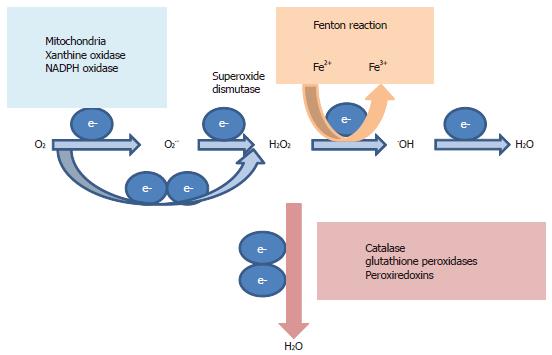Copyright
©2014 Baishideng Publishing Group Co.
World J Gastroenterol. Mar 21, 2014; 20(11): 2785-2800
Published online Mar 21, 2014. doi: 10.3748/wjg.v20.i11.2785
Published online Mar 21, 2014. doi: 10.3748/wjg.v20.i11.2785
Figure 4 Oxidant and anti-oxidant systems.
During active respiration in the mitochondria, electron leaked from the respiratory chain reacts with oxygen (O2) to form reactive oxygen species (ROS) superoxide anion O2.- and pro-oxidant-hydrogen peroxide (H2O2). O2.- is quickly dismuted to H2O2 in a reaction catalyzed by superoxide dismutase. Non-mitochondrial sources of O2.- and H2O2 include cytosolic xanthine oxidase and plasma membrane nicotinamide adenine dinucleotide phosphate (NADPH) oxidase. H2O2 is decomposed by iron in the Fenton reaction to yield the highly oxidizing hydroxyl radical .OH, causing macromolecule damage, DNA damage and lipid peroxidation. H2O2 can be reduced to water (H2O) by catalase, glutathione peroxidases and peroxiredoxins.
- Citation: Chan SW. Establishment of chronic hepatitis C virus infection: Translational evasion of oxidative defence. World J Gastroenterol 2014; 20(11): 2785-2800
- URL: https://www.wjgnet.com/1007-9327/full/v20/i11/2785.htm
- DOI: https://dx.doi.org/10.3748/wjg.v20.i11.2785









